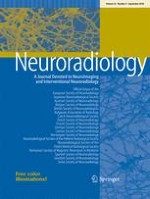Published in:

01-09-2010 | Interventional Neuroradiology
Fragmentation of calcified plaque after carotid artery stenting in heavily calcified circumferential stenosis
Authors:
Masanori Tsutsumi, Tomonobu Kodama, Hiroshi Aikawa, Masanari Onizuka, Minoru Iko, Kouhei Nii, Shuko Hamaguchi, Housei Etou, Kimiya Sakamoto, Ritsurou Inoue, Hiroya Nakau, Kiyoshi Kazekawa
Published in:
Neuroradiology
|
Issue 9/2010
Login to get access
Abstract
Introduction
We assessed the morphological change of calcified plaque after carotid artery stenting (CAS) in vessels with heavily calcified circumferential lesions and discuss the possible mechanisms of stent expansion in these lesions.
Methods
We performed 18 CAS procedures in 16 patients with severe carotid artery stenosis accompanied by plaque calcification involving more than 75% of the vessel circumference. All patients underwent multidetector-row computed tomography (MDCT) to evaluate lesion calcification before and within 3 months after intervention. The angiographic outcome immediately after CAS and follow-up angiographs obtained 6 months post-CAS were examined.
Results
The preoperative mean arc of the calcifications was 320.1 ± 24.5° (range 278–360°). In all lesions, CAS procedures were successfully carried out; excellent dilation with residual stenosis ≤30% was achieved in all lesions. Post-CAS MDCT demonstrated multiple fragmentations of the calcifications in 17 of 18 lesions (94.4%), but only cracks in the calcified plaque without fragmentation in one (5.6%). Angiographic study performed approximately 6 months post-CAS detected severe restenosis in one lesion (5.6%) without fragmentation of calcified plaque.
Conclusions
Excellent stent expansion may be achieved and maintained in heavily calcified circumferential carotid lesions by disruption and fragmentation of the calcified plaques.